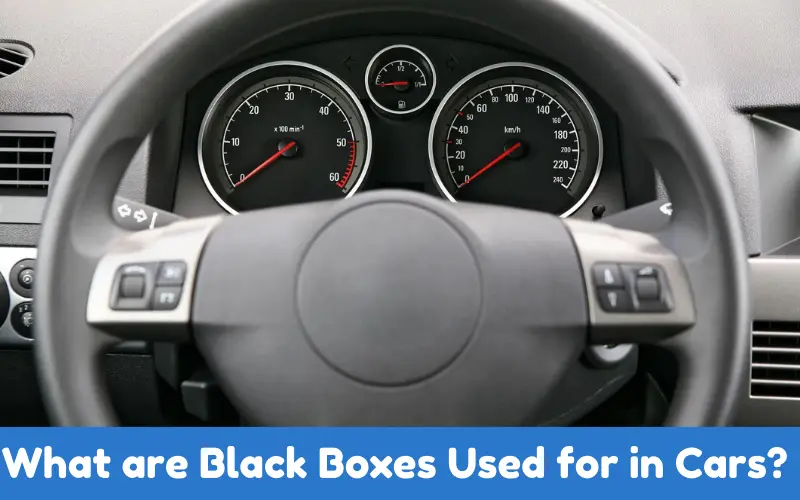Nowadays, our lives depend on technology, especially on things that we use daily. Our personal car also has many technological advancements.
One of the best things used nowadays is black boxes in cars of any kind. Black boxes are used in aero-planes as information units to record flight information in reports, and they are also used in daily drivers.
However, what could they do for our vehicles? And why are all of them important? Let’s discuss the purposes, benefits, and drawbacks of devices.
Article Summary
What Are Black Boxes?
Today, few of us baulk at having a black box or an Event Data Recorder (EDR) installed in our cars because we already have them.
They’ve been used since the 1990s and are increasingly standard equipment because of regulations in several territories.
They record various performance information, such as whether we were wearing our seatbelts, if we braked hard, and how fast we were going.
How Do They Work?
Black boxes turn on in case something bad happens. For example, if there is a crash, the box keeps collecting data before and after the event.
The box will let us know what was going on at the time and remember information so it can be useful later. It can hold between five and 20 seconds of data on small devices.
That doesn’t sound like a lot, but sometimes, all we need is a few seconds to know exactly what happened.
What are Black Boxes Used for in Cars?
Black boxes on cars are known more formally as Event Data Recorders (EDRs). They record and store data on a vehicle’s performance during an impending event, usually an accident.
The black box records the vehicle’s speed, throttle or accelerator pedal level, whether the brake pedal was depressed, whether the airbag deployed, and whether the driver was wearing a seatbelt before and during the crash.

The primary purpose of black boxes is to aid in investigations when an accident occurs. They record data that’s useful and pertinent to an accident inspection.
Besides assisting with crash investigations, EDRs can enhance vehicle safety, as automakers can utilize the data to upgrade certain design parameters to create safer vehicles.
In addition, insurers can utilize black box data to determine accident claims more efficiently. Cummings notes that ‘certain black boxes can be utilized to gather data concerning how drivers operate their vehicles and can influence them to drive more safely to reduce their insurance premium.’
Insurance companies aim to use black box information as a primary tool for determining insurance matters.
Uses of Black Boxes in Cars
What is the reason for black boxes in cars? Safety is the most important role that black boxes play in cars.
They are a handy tool for engineers to examine previous accidents and find out the causes of those accidents, thus making cars safer. Car makers commonly examine black box data to enhance safety each year.
In addition to car makers, insurance firms increasingly use black boxes to ascertain liability in accidents, using black box data to support or dent a driver’s claims in severe accident court cases.
Drawing on the data from black boxes helps investigators determine whether these accidents were caused by the driver or the vehicle. You want good, hard facts when trying to understand something.
Benefits of Black Boxes
Car black boxes give an unbiased account of the event, which can be enormously useful in a chaotic situation where emotions run high.
They provide an unvarnished report of the hows, wheres, and whens of the incident without any of the mutual recriminations that can result from more subjective accounts of the accident.
This is good news for drivers, too. If you’re unlucky enough to have an accident that wasn’t your fault, black box data can demonstrate that you weren’t, say, tailgating or speeding. On the other hand, it can just as easily demonstrate that you were.

They’re also a godsend for insurance adjusters. Some companies are so confident in the technology that they’ll give discounts to drivers who install black boxes to track their driving habits. It’s a win win for the companies. They encourage safer habits, which saves them money.
The National Highway Traffic Safety Administration (NHTSA) argues that black boxes will reduce injury accidents by helping design safer vehicles and improve safety systems.
Based on this anecdotal representation of what the black box will do, the logic seems impeccable: better data leads to better safety.
Challenges and Concerns
Nowadays, all new cars or old repaired cars have black boxes installed. It is undeniable that black boxes have both positive and negative effects.
On the one hand, the major dilemma arises as black boxes violate the principle of driver privacy.

Questions may arise, such as, “Is the driver aware that every action he makes is filmed?” And who is the owner of that data? The car owner or manufacturer? It could also be employed without the driver’s consent in a legal proceeding.
Moreover, how can we be certain that data is being interpreted correctly and not subject to tampering, especially when a driver, passenger, or bystander could be at risk of injury or worse based on the data’s accuracy?
Conclusion
Follow the link to read the full commentary. Black boxes in cars (or, more properly, event data recorders, or EDRs as they are sometimes called) are currently more important than ever for assessing road safety in terms of both vehicle design and driver behavior.
These small electronic devices, which can record parameters such as vehicle speed, braking, and the deployment of airbags during accidents, provide extremely useful information for crash analysis.
Their data has tremendous potential for improving vehicle safety systems. By studying accident reports and related black box information, car manufacturers can make future versions of their vehicles even safer.
From the perspective of the driver and its insurance companies, the use of black boxes also represents a technological advancement with potential benefits.
By holding drivers more accountable for their behavior, the EDRs facilitate the provision of better insurance coverage, with lower costs for good drivers.
On the other hand, using EDRs raises numerous concerns, such as privacy risks and ethical questions about who owns the data.
If their use continues to spread, ensuring that black boxes are used to empower people while respecting their data privacy will be a key challenge to address.

